This is a Bencini Koroll II made by Bencini in Milan, Italy starting around 1962. It is a strange medium format camera designed to use 120 roll film, but takes small 30mm x 45mm exposures which are only slightly larger in size than 3cm x 4cm images shot on 127 roll film. The Koroll series was in production starting in 1951 and ran through the mid 1960s. All Korolls were basic cameras with simple lenses and shutters. Some took 6×6 images on 120 film, and some used regular 35mm film taking standard 24mm x 36mm shots. Despite their long production run, they rarely were exported out of Italy, so finding information about them elsewhere in the world is difficult.
Film Type: 120 Roll Film (twenty four 30mm x 45mm exposures per roll)
Lens: 55mm f/9 Bencini Acromatico (probably single element meniscus)
Focus: 4 feet to Infinity
Viewfinder: Scale Focus
Shutter: Spring Tensioned Metal Blade
Speeds: B, 1/50, and 1/100 seconds
Exposure Meter: None
Battery: None
Flash Mount: ASA Sync Port and Cold Shot
Manual: https://www.flickr.com/photos/e-coli/sets/72157603627244207/
History
It’s easy to forget that not every camera made over the past 100 years came from Japan, Germany, the Soviet Union, or the United States. In fact, many countries produced cameras, England, Poland, Czechoslovakia, and even Italy. Finding models made in these lesser known countries can be a challenge, but one that I regularly would see show up was Bencini.
 Bencini was an Italian maker of low to mid range cameras that was active from 1937 to the late 1980s. The company was founded by Antonio Bencini in 1937 and located in Milano, Italy. There isn’t a lot of English language information regarding the history of Bencini, so what follows is my best attempt at interpreting the poor Google translation of Donato Consonni’s Italian language Bencini history page. Google Translate has come a long way, but it’s still not perfect, so there were many times where I had to improvise some of the scrambled English to put together what I think Mr. Consonni was trying to say.
Bencini was an Italian maker of low to mid range cameras that was active from 1937 to the late 1980s. The company was founded by Antonio Bencini in 1937 and located in Milano, Italy. There isn’t a lot of English language information regarding the history of Bencini, so what follows is my best attempt at interpreting the poor Google translation of Donato Consonni’s Italian language Bencini history page. Google Translate has come a long way, but it’s still not perfect, so there were many times where I had to improvise some of the scrambled English to put together what I think Mr. Consonni was trying to say.
Antonio Bencini was born in or around Florence, Italy in the very late 1800s. His exact date of birth is not known, but since he did serve in the first World War, its likely he was at least in his upper teens to early 20s during the war, putting his date of birth somewhere between 1895 and 1900. During the war, Bencini was an aeronautical engineer where cameras were regularly used as surveillance equipment. The Italian military would source it’s cameras from an unknown French company as there likely were no Italian manufacturers building them at this time. Whenever these cameras would become damaged and need repair, they needed to be sent back to the manufacturer in France.
Sensing a need to be able to repair and possibly even build his own cameras, Bencini sought and received permission from his superiors to attempt the repair of these cameras himself. Bencini’s efforts at repairing these cameras eventually allowed the Italians to be less reliant on outsourcing their repairs.
After the war, Bencini decided to capitalize on his experience gained repairing the French cameras and opened his own carpentry shop in Florence where he built and repaired cameras and magnifying devices.
In 1920, Bencini either worked for, or worked in cooperation with Fratelli Alinari, a photography firm established in 1852. I had difficulty translating this portion of the history, but it would seem that Bencini might have been an independent contractor for a variety of Italian firms.

In 1931, Bencini either founded or worked for another photographic firm called FIAMMA, which is an Italian acronym for Fabbrica Italiana Apparecchi Macchine Materiali Accessori, which loosely translates in English to “Italian Equipment Accessories and Materials Factory”. FIAMMA would produce a variety of box and folding bellows cameras for the amateur and professional market. One such camera was the Fiammetta, an elegant, all metal box camera that shot 6×4.5 and 6×9 images on 120 roll film.
FIAMMA would be acquired in 1935 by Ferrania, who at the time was the largest producer of film in Italy and one of the most influential Italian companies. Ferrania still exists to this day as a maker of black and white film stocks.
Around the time of FIAMMA’s acquisition by Ferrania, Antonio Bencini relocated to Turin, Italy and formed another company continuing to make inexpensive box cameras. Again, this portion of the history was hard to understand, but it sounds like in 1937, Bencini’s new company was also acquired by Ferrania.
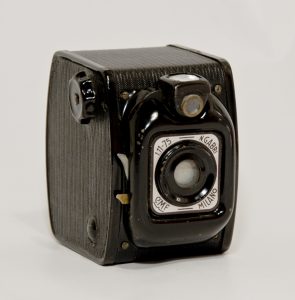
It would seem that Bencini had no intention of working for someone else, as each time one of his companies was acquired by someone else, he would start up another. Once again, Bencini would start a new company called ICAF. I could not find any info about whether that is another acronym or what it stands for. ICAF would make simple box and folding cameras for the amateur photographer. These cameras would have names like Robi and Gabri, which were named after Bencini’s two children, Roberto, and Gabriella.
During World War II, now known as CMF, the company would cease camera operations and produce bicycles and aviation supplies. After the war, camera operations would resume with a few pre-war models being made, along with a variety of new ones.
In 1946, Antonio Bencini’s son Roberto, would take over the company and the name would change once again to CMF-Bencini. The late 1940s and early 50s would see the release of Bencini’s most successful models, the Comet, Relex, and in 1951, the Koroll. The Comet was the company’s smallest camera, shooting 4cm x 3cm images on 127 film and was made using a solid die-cast aluminum body. The name “Comet” was chosen as it was the same as a new type of airline jet engine that had debuted at the same time. The look of the all metal body was supposed to hint at the company’s aviation history. The Relex was a little larger, shooting 4cm x 6cm images on 127 film, and the Koroll was the largest, using 120 film, it could shoot images as large as 6cm x 6cm. At some point in the early 1950s, the company would drop “CMF” from it’s name and be known simply as Bencini.
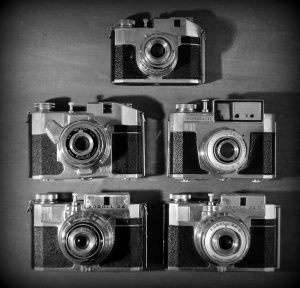
All of Bencini’s models were inexpensive, entry level cameras designed to allow people to experience photography in a variety of sizes, without investing much money. It was perhaps this goal of catering to the beginner that gave the company the most success. Most Bencini cameras were designed for either 120 or 127 roll film, although they did eventually release a few 35mm models. Strangely, the Bencini Koroll would take 120 film, but shoot negatives that were no larger than those shot on 127 film, wasting some of the available surface area of the 120 film.
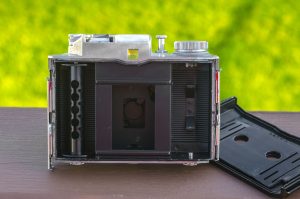
The Koroll would be the company’s most successful line of cameras, staying in production for about 15 years, and spawning at least 8 different variants. The model being reviewed here is an early Koroll II, probably from around 1962. The earliest variants of the Koroll II had an f/9 Bencini Acromatico lens and a 2-speed shutter. Later variants would have an f/8 lens and a 3-speed shutter.
The Bencini II shoots twenty four 3cm x 4.5cm images on 120 roll film. I could never find out why Bencini chose to use 120 film in a camera that made images that were the same size as that of a 127 camera, when they also made 127 film cameras. Why not just design the Bencini II to use 127 film in the first place and not waste film? If I had to guess it would be that a roll of 120 film is physically longer than a roll of 127 film, and by using 120 film, you could get 24 exposures out a roll instead of 16 like on a traditional 127 film camera.
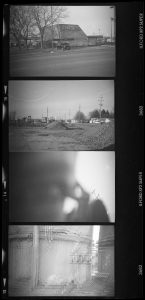
I do not know how many Bencini models were exported, or if they were all sold in Italy. During my research for this article, I could not find any English language magazine reviews or advertisements from the era. I couldn’t even find any kind of prices or marketing information for the line, suggesting they weren’t often sold out of their domestic country. A quick eBay search for “Bencini” results in only 20 matches, the majority of which were from sellers in Europe, which suggests that these models were not exported to the United States.
In the years that would follow, Bencini continued to make inexpensive cameras for the amateur market all the way through the 1980s. It would seem the company struggled during it’s last two decades, but managed to hang on, eventually going out of business around 1987.
Today, Italian made cameras are a curiosity to many camera collectors. The Koroll line is probably the easiest to find as it was likely the most popular. In production for nearly 15 years, and selling for a modest price, there’s probably quite a few of them still out there. It has a unique look, and in the case of the Koroll II, is one of the only cameras ever made that used 120 film and shot 3cm x 4.5cm exposures. It’s a really neat camera due to it’s simplistic design, most still work fine today.
My Thoughts
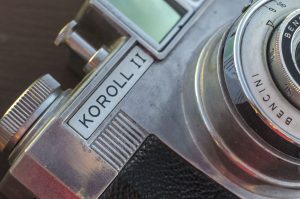
I knew nothing about the Koroll lineup the first time I saw this camera, so I had no idea what it was. It’s size suggested a 120 roll film camera, which turned out to be correct, but there was no way I could know it makes twenty-four 30mm x 45mm images per roll.
Even after wrapping my head around it, I still cannot understand why Bencini designed the camera this way as there simply is no reason, especially considering 127 film was still in frequent use during this time and it would have made nearly identical 30mm x 40mm images and resulted in a physically smaller camera.
Regardless of the reason, the Koroll II stands alone as a strange relic of the past. It’s all metal body and fully focusing lens suggest a step up from a simple box camera, but it’s single element lens and limited selection of shutter speeds and aperture sizes suggest otherwise. Since I was unable to find any indication of price when new, I can only speculate that this camera was likely sold as an entry level camera to those who had no desire to learn the intricacies of a more advanced camera.
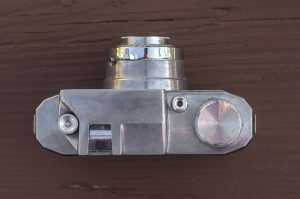
Still, the Koroll II isn’t without it’s charm. The large and bright viewfinder make composition a snap. The top plate self-cocking shutter release is comfortably located and easy to use. Although the camera lacks any sort of double image prevention, at least you don’t have to separately cock the shutter before each image. The all metal body is lightweight, but sturdy. This camera likely took more of a beating than similar Bakelite plastic cameras of the period would have handled. What looks to be a selenium light meter is merely just a stamped metal decoration near the front viewfinder window. Finally, the aperture and shutter speed selectors are both up front around the perimeter of the lens exactly where you’d expect them to be.
When the Bencini arrived, I could see that it already had a roll of film in it. Without being able to open the film compartment, I had to rely on what little I could see through the red window, and upon advancing the film, I immediately recognized the unique circular dot pattern that precedes the frame numbers on Ilford black and white film. Also, to my surprise, the frame counter was on the number 2, which suggests that most of the roll had yet to be exposed. Since this camera allows for 24 exposures per roll, I should have at least 20 to shoot myself, so I made the decision to finish the roll. I sacrificed one exposure and fired it while looking at the lens so that I could be sure the shutter was working, and it was.
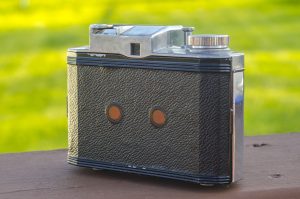
Like other half frame 45mm x 60mm 120 or 30mm x 40mm 127 cameras, there are two red windows on the back of the camera that must be used to properly advance the film. The Koroll uses the “middle” frame numbers that a 6×6 camera would normally use, and as you advance the film, you must stop as each number appears in both windows. So for example, for the first exposure, stop when the number 1 is on the left window and take your photo. For the 2nd exposure, wind the film until the number 1 is in the right window. For the 3rd exposure, wind the film until the number 2 is in the left window, and so on. Normally when using the 6×6 frame numbers in a 6×6 camera, you get 12 60mm x 60mm exposures per roll, but since this is a half frame camera, you get 24 30mm x 45mm. The top 15mm of the film remains unexposed.

The Koroll II has no focus aide, requiring you to estimate the distance between yourself and your subject to get properly focused images. The Koroll’s small apertures of f/9 and f/16 make this pretty simple as the small apertures give you a rather large depth of field range to maximize the zone in which your images will be sharply in focus.
Using a depth of field calculator for a 55mm lens on 120 film, and apertures of f/9 and f/16, the following zones will be in focus at the following distances:
| f/9 | f/16 | |
| 6 feet | 4.85 feet to 7.86 feet | 4.22 feet to 10.4 feet |
| 15 feet | 9.36 feet to 37.8 feet | 7.23 feet to infinity |
| 20 feet | 11.1 feet to 103.6 feet | 8.2 feet to infinity |
As you can see, even at f/9, there is a wide range of focus for everything but closeups. If you were shooting the Koroll on a bright and sunny day, you could leave the camera set to f/16 and 15 feet and shoot it like a fixed focus camera with everything 7.23 feet and beyond in focus.
I enjoyed shooting the Koroll much in the same way I enjoy shooting a box camera. Although the camera isn’t small enough to fit in your pocket, it’s lightweight aluminum body is easy to transport. The large and bright viewfinder and top plate shutter release, combined with the wide depth of field range make for an extremely easy camera to shoot. As I write this, I haven’t yet seen the images it makes, but if they’re anything short of miserable, I feel as though I can already conclude that this is a great camera to add to any collection.
My Results
It’s not unusual to find a partially shot roll of film inside of a camera, but in most cases, the images are so far gone they’re not worth developing or saving. Even when you do manage to get an image from someone else’s film, its rarely anything of interest. On rare occasions however, someone finds images of Mount St. Helens erupting on a thrift store roll of film found in an Argus C3.
In this case, I was able to easily identify that the roll of film was rather recent Ilford black and white film. Ilford has unique circle shape markers that appear before each frame number which let you know when you should stop winding. These markings are unique to Ilford, and I was able to reasonably guess that the film inside of the Koroll was recent, and I could see it was only on the 3rd exposure out of 24, so I decided to just finish the roll.
This is the first time that I have ever reviewed a camera based off a roll of film that I found inside of a camera when I received it, so there was some level of risk. Thankfully, black and white film is inexpensive to develop, so other than wasting my time, I had little to risk. I had to assume that whoever installed this roll into the camera, chose a speed that was suitable for the Koroll’s limited shutter speeds, so I performed Sunny 16 calculations assuming I had a 100 speed film.
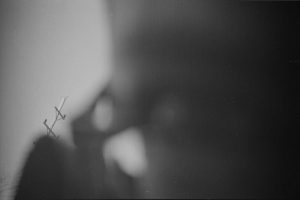
The Koroll has a basic 2 speed shutter that is tensioned by a simple spring. This means the shutter is extremely quiet when firing and it can be difficult to hear it working. I noticed that the 1/100 speed was louder as the spring has more tension and has to spring back quicker, but the 1/50 speed was almost inaudible. As a result, there were several times where I was attempting to use the slower speed where I wasn’t sure if it was firing, and I ended up with a shot like the one to the right. Its probably hard to make out what that is, but that’s my face looking into the lens with a distant image of power lines in the background!
Aside from the several sacrifices I made with this roll, when you have a camera that gives you 24 images per roll, you should still get a few good ones, and that’s exactly what happened.
It looks like my instincts to shoot the film as a 100 speed film were spot on. Exposure was mostly correct in every image, even the ones where I shot it at 1/50.
In all of my research for the Bencini Koroll, I could not find any information about the make up of the lens so I assumed that it was a single element meniscus lens. Looking at the images, I would have to agree that it probably is. Center sharpness is very good, but it drops off quickly towards the edges. The lens also gives a heavy vignetting effect which is seen in every image, but oddly seems to be more pronounced on one side over the other. Vignetting, sharp and clearly defined centers with heavy softness near the edges are all characteristics of a meniscus lens. It’s still possible this is a doublet lens, but I doubt it.

While I am generally pleased with the vintage look that the Koroll gives, and my exposure estimates were pretty good, the thing I am most impressed on was how every shot was in focus. This is a scale focus camera with no focus assistance. I mention earlier in this review that the Koroll has a very wide depth of field allowing for a lot of latitude in focus estimates, and that proved to be true.
If you were in the market for an inexpensive Italian camera in the early 1960s, this camera would have definitely been an appealing model. What it lacks in impressive stats, it more than makes up for in simplicity and ease of use.
The Bencini Koroll is not a camera I ever thought I would have in my collection, but now that it’s here, I am glad it found it’s way to me. I am constantly impressed with the quality of images that simple cameras are capable of. When you shoot a precision SLR or rangefinder camera with a sharp 6-element lens and helical focus, you expect good images. But when you shoot what amounts to be a hollow box, a single piece of glass, and a spring loaded metal blade, and you get anything close to good, you’re pretty happy. It is clear to me that Antonio Bencini knew what was doing, and although he won’t ever have the reputation of Oskar Barnack or August Nagel, he found his niche, and filled it quite nicely!
My Final WordHow these ratings work |
Every camera designed and made by Bencini was inexpensive and basic, and the Koroll II is no different. Designed with a simple shutter and lens, it was aimed at the low end of the market, but has a full focus lens which means its a step up from many focus free cameras of the day. This particular model has an interesting feature where it shoots twenty four 4.5cm x 3cm images on a single roll of 120 which means you get twice as many shots per roll. The lens is capable of good center sharpness, but it softens quickly near the edges suggesting this is a single element lens. The Koroll II was a lot of fun to shoot and in my first roll, I never once missed focus and my exposure was pretty spot on. Getting 24 images out of the roll only adds to the appeal. This is a cheap and interesting looking camera with a feature set that’s not commonly found on any other model. They wont show up for sale often in the United States, but if you have an opportunity to try out one, I highly recommend it. | ||||||
| Images | Handling | Features | Viewfinder | Feel & Beauty | History | Age | |
| 1 | 1 | 1 | 0 | 1 | 0 | 20% | |
| Bonus | +1 for value and overall simplicity | ||||||
| Final Score | 5.8 | ||||||
Additional Resources
http://camerapedia.wikia.com/wiki/Bencini_Koroll
http://bencinistory.altervista.org/20sch_koroll2.html
https://internoinbakelite.wordpress.com/2012/06/22/bencini-koroll-2-o-ii/
http://www.collection-appareils.fr/x/html/page_standard.php?id_appareil=2366
https://www.photo.net/discuss/threads/bencini-koroll-photos.156973/

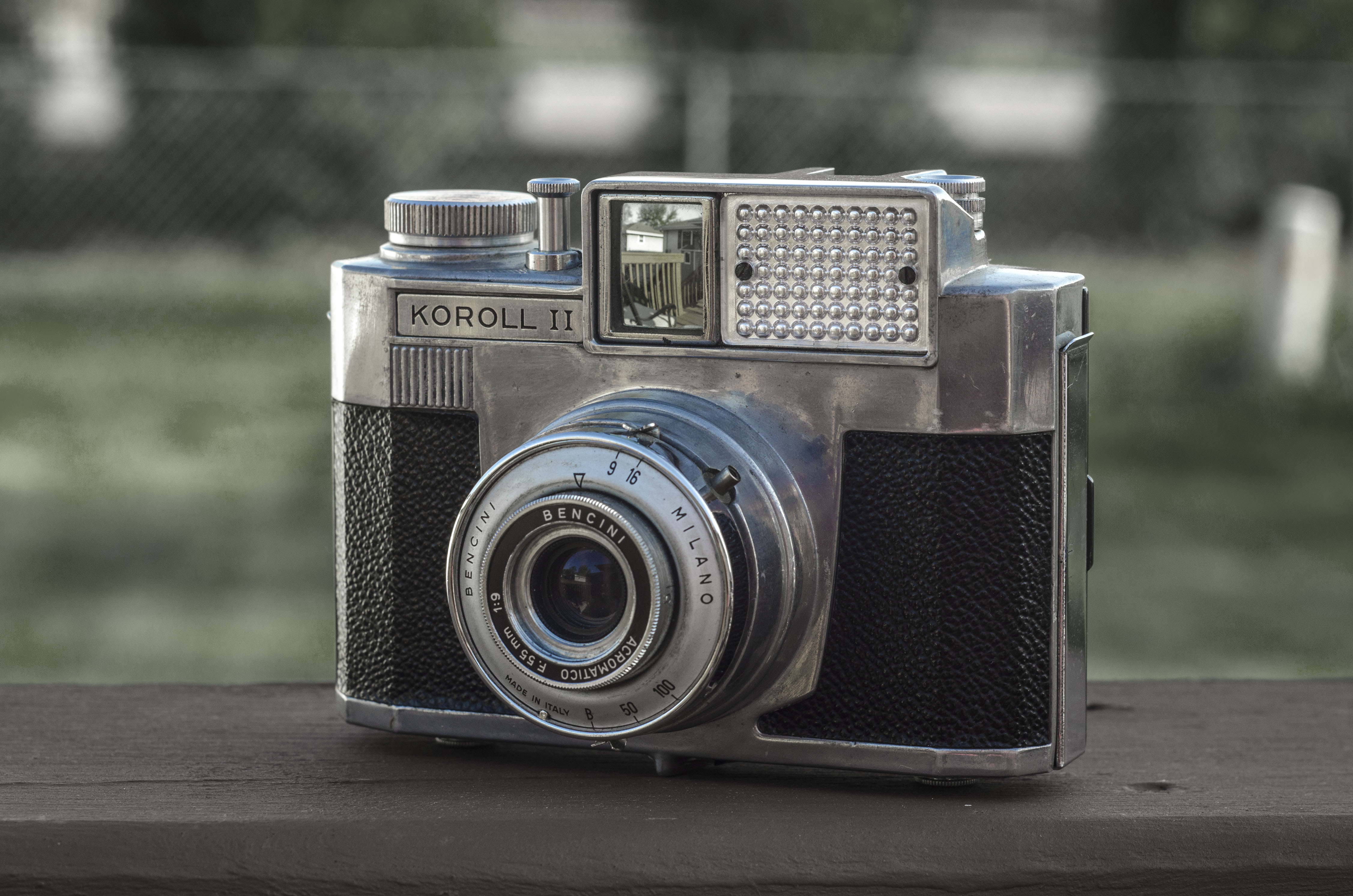
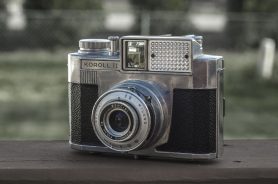
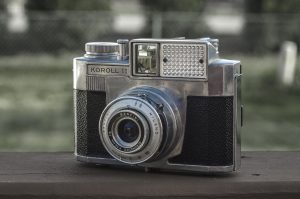








Thank you for this complete article, I understand the difficulties to gain resources for this italian camera. Make film great again 🙂
Thanks! I just visited your website, and it looks like you are base in Italy, so it’s even more of a compliment to receive one from an Italian person on an Italian camera! If you find anything from my review that is incorrect or missing, please let me know!
You did a huge research, nothing seems to be incorrect to me. Enjoy your “half-medium format camera”!
Just caught up with your very well researched article. In England we have a large pharmacy chain called Boots the Chemist now owned by Walgreen. I’m pretty sure Bencini made the own brand cameras for Boots for many years. There are often boots cameras for sale on eBay.co.uk
Can you take a little grammatical criticism?
When you say “It’s a good thing” one uses an apostrophe (short for “It is a good thing” ) but not when you say “ Sharing its benefits” (ie sharing the benefits belonging to it). I know I’m being petty but it spoils your really fascinating writing and not just in this article
“It’s a good thing there are people like you out there enjoying photography and selflessly sharing its benefits with the rest of us”
Thanks for the compliments on the Bencini article! That was a fun a little camera that I really should revisit someday!
Ironically, you are the 4th person to comment about my misuse of its and it’s. One guy even went as far as to say that it drove him so crazy that he would stop reading my site! It would seem this single grammatical snafu seems to really hit a chord with camera collectors!
The thing is, I do know the difference between the two words and when it’s appropriate to use them, I just seem to mistype it often. The online editor in WordPress has a spell check, but since both its and it’s are correctly spelled it does not flag them and when I am proofreading each article, which on average is between 4000-6000 words, sometimes even much longer, overlooking a tiny apostrophe is quite easy to do. I do make the effort, and I’m sure if you look for them, you’ll see many more instances where I use those words correctly! 🙂
That said, thanks for the feedback, I appreciate criticism of all kinds, it helps me get better!
Great article. I got one of these cameras through a garage sale here in Canada. Took quite awhile to find more then just a basic specs page with the same info found right on the camera. So far I am having fun with it.
Hi! I’ve been an inactive photographer since the 1970s and 1980s (Miranda Sensomat RE which I loved) and have recently gotten interested in vintage cameras. I don’t know why, but I was immediately attracted by an original Koroll (predecessor of the Koroll II) introduced in 1951, which I first saw on Etsy. It took standard 6×6 photos on 120 film, had a single shutter speed (1/30 second) aside from B, and a fixed aperture (f11). I’d love to someday get a working one.
I discovered on another site listed in some Google results for Bencini that “Bencini was an Italian camera brand founded in 1937 as I.C.A.F. (Industria Costruzione Apparecchi Fotografici)”. I’m don’t yet know what CMF was. (I’ve just learned this today after being inspired by your article.)
The Robi and Gabri cameras were originally called Roby and Gabry, but the fascist government frowned on the use of non-Italian names, so Bencini renamed them with the “i”.
The coolest Bencini camera of the 1950s has got to be the Comet III ( https://vintagecameralab.com/bencini-comet-iii/ ), a 127 camera with a vertical body that looks like an 8mm movie camera. With one shutter speed of 1/50 second, fixed aperture (f8), and a fixed-focus lens! I’d love to get one of these someday too.
I believe I read an article by you about film options for 127 cameras several years ago; I had been searching for information about the Univex Mercury cameras and I browsed through and read a bunch of your other articles at the time. In the past month, I’ve read instructions for various methods of rolling your own 127 film including the backing paper. Some methods don’t use backing paper, which I believe was the method you described, and, as you noted at the time, requires doing a good job of sealing up the red window.
I picked up my Univex Mercury camera from a yard sale in the 1970s, but I don’t remember ever shooting any photos with it. I learned from your article that it used proprietary film and that the half moon on the top of the camera was not an ornamental feature, as I had thought for some decades, but was necessary for the shutter.)
Thanks for your many great articles!
Thanks for the kind comments Alex. The Bencini is definitely a cool camera and has one of the quietest shutters of any camera I’ve ever used. The one problem with reviewing as many cameras as I do, is there’s so many cool ones like these that I’d like to get back to and shoot again, but there’s so many new cameras to review that it’s hard to find the time!
And you’re right, some paper backed film cameras can be loaded without paper, but it requires them to not have a red window, or if they do, you need to tape it over. I was able to roll regular 35mm in an original Univex Mercury without a spool, simply by “free-rolling” it into the supply chamber. Of course, this required a lot of gaffers tape to seal up the film compartment!
Olá! tenho uma Bencini Koroll 2, para vender. Herdei do meu pai e não lhe dou uso. Se alguém estiver interessado, p.f., contacte-me. Mando fotos da máquina.
Hi! Just picked one up (the “III”, actually) at an antique shop for AU$60 (did the usual basic tests of “Does the shutter fire”; “Does the shutter speed change as you change the dial”, etc. — seemed to work).
Was just Googling and found out it was half-frame!!! (Love it.) And then found your article.
Many thanks for your thorough investigation and description — including how to use the pair of red windows to represent the exposure number. 🙂 It is a service to the community.
Nice find on the III! I am glad you enjoyed the review, thanks for the feedback!
Hi
I chanced on your article when I searched Koroll II on Google, I was gifted this camera model as a young boy by my Italian uncle when on holiday in Italy in 1960, my model is the 120 version that takes 24 exposures, I used it extensively in my early photographic formative years, and still have it! As an aside the Koroll II models were marketed in the UK in the larger Boots the Chemist stores. And may I finally add that your research and review made for interesting and absorbing reading, I really had no idea of the history or indeed the background to the Bencini brand of camera’s, or even that they were from Milan, where another Italian uncle of mine had a grocery store in Corso Buenos Aries. Thank you for an excellent insight into my cherished gift.
Michael, I am happy you enjoyed the article and were able to learn a little more about your Bencini!